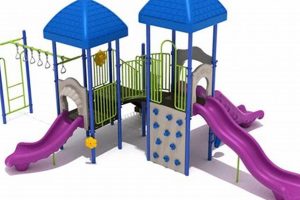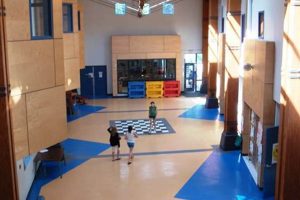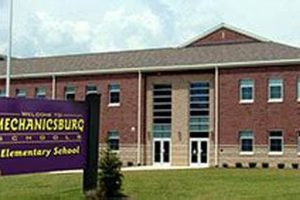Publicly funded institutions offering specialized curricula often focus on areas like science, technology, engineering, mathematics (STEM), arts, or foreign languages, attracting students from diverse geographical backgrounds within a local district. For example, a school specializing in performing arts might draw students from across the city interested in intensive music or theater training. These specialized educational programs are designed to foster specific talents and interests, enriching the overall learning experience.
These specialized schools aim to improve educational equity and provide enriched learning opportunities. Historically, such programs emerged as a method of voluntary desegregation, drawing students from various neighborhoods to specialized programs within a district. By offering unique educational focuses, they can increase diversity within schools and provide students with opportunities they might not otherwise encounter in their neighborhood schools. This can lead to a richer learning environment and a wider range of perspectives for all students.
The following sections will delve further into specific program examples, the application process, and the benefits and potential drawbacks of choosing this type of educational setting.
Tips for Finding and Applying to Specialized Elementary Schools
Locating and securing placement within a specialized elementary program requires careful planning and research. The following tips offer guidance for families considering this educational path.
Tip 1: Research Program Focus: Thoroughly investigate the specific academic concentrations offered by various schools. A school focusing on STEM will differ significantly from one specializing in the arts. Alignment between a program’s focus and a student’s interests and aptitudes is crucial.
Tip 2: Consider Commute Times: Specialized programs often draw students from across a district. Factor in travel time and transportation logistics when evaluating school options. Longer commutes can impact family schedules and a student’s overall well-being.
Tip 3: Understand Application Requirements: Application processes vary between schools and may include essays, test scores, auditions, or portfolios. Carefully review the specific requirements for each program of interest well in advance of deadlines.
Tip 4: Attend Open Houses or Virtual Tours: Visiting schools, either in person or virtually, provides valuable insights into the learning environment, school culture, and available resources. This allows families to assess whether the school is a good fit for their child.
Tip 5: Prepare for Assessments: If the application process involves entrance exams or auditions, adequate preparation is essential. Practice tests, mock auditions, or portfolio reviews can enhance a student’s performance and confidence.
Tip 6: Explore After-School Programs: Specialized schools may offer unique extracurricular activities aligned with their program focus. Investigating these options can provide further insight into the enrichment opportunities available.
Tip 7: Connect with Current Families: Speaking with families whose children are currently enrolled in the program can provide valuable firsthand perspectives on the school’s strengths and weaknesses.
By following these guidelines, families can navigate the application process effectively and increase their chances of securing a placement in a program that aligns with their child’s needs and aspirations.
In conclusion, choosing the right educational path for a child requires careful consideration of various factors. The information provided here serves as a starting point for families exploring specialized elementary school options.
1. Specialized Curriculum
Specialized curricula represent a core characteristic of magnet elementary schools, differentiating them from traditional neighborhood schools. This focused approach to education plays a significant role in attracting students from diverse backgrounds within a district. A strong emphasis on specific subjects, such as science, technology, engineering, mathematics (STEM), arts, or world languages, caters to individual student talents and interests. For instance, a school specializing in STEM might offer advanced robotics courses and coding workshops, fostering critical thinking and problem-solving skills. Conversely, an arts-focused program might provide intensive music instruction, theatrical productions, and visual arts studios, nurturing creativity and artistic expression. This targeted curriculum directly impacts student development, providing opportunities not readily available in standard elementary settings.
The availability of specialized curricula allows families to select educational environments aligned with their children’s aptitudes and passions. A student with a pronounced interest in science might thrive in a STEM-focused magnet program, benefiting from advanced coursework and hands-on learning experiences. Similarly, a budding artist might flourish in a school with a robust arts curriculum, gaining access to specialized resources and mentorship from experienced professionals. Such programs provide a pathway for students to develop their skills and pursue their interests from an early age. This focused approach fosters a deeper engagement with learning and can contribute to long-term academic and career success.
The deliberate focus on specialized curricula within these schools contributes significantly to their overall appeal. By providing unique learning opportunities, these institutions cater to diverse student populations and foster specialized skill development. The intentional cultivation of specific talents and interests provides students with a competitive edge, preparing them for future academic pursuits and career pathways. While the application process and logistical considerations remain important factors, the specialized curriculum ultimately serves as the primary driving force behind families seeking enrollment in these programs. Recognizing the distinct educational opportunities these curricula offer is essential for families considering magnet school options.
2. Application Process
The application process serves as a crucial gateway to specialized elementary programs, acting as a filter to ensure appropriate student placement within these unique learning environments. Unlike traditional public school enrollment, which is typically determined by residency, admission to these specialized programs often involves a competitive selection process. This process aims to identify students who demonstrate a strong aptitude or interest in the program’s specific focus area, whether it be STEM, the arts, or a foreign language. The rigor of the application process varies among programs and may include components such as standardized test scores, essays, portfolios, auditions, or interviews. For example, a STEM-focused program might weigh heavily on math and science test scores, while an arts program might require an audition or portfolio submission. This selective process ensures that admitted students are well-suited to the program’s rigorous curriculum and specialized learning environment.
Understanding the application process is essential for families considering specialized elementary school options. Timelines, required documentation, and evaluation criteria differ among programs. Early research and preparation are crucial for navigating these requirements successfully. Missing deadlines or submitting incomplete applications can significantly impact a student’s chances of admission. Attending informational sessions or consulting school websites can provide valuable insights into the specific procedures and expectations. For instance, some programs prioritize students who reside within a specific geographic area, while others prioritize demonstrable talent or interest. Proactive engagement with the application process increases the likelihood of a positive outcome, allowing families to strategically pursue educational opportunities aligned with their children’s strengths and aspirations. This informed approach positions families to make the most of the available options and increases their chances of securing a spot in their desired program.
In summary, the application process plays a defining role in shaping the student body within specialized elementary schools. Its selective nature ensures a focused learning environment conducive to the program’s specific educational goals. A thorough understanding of this process is essential for families seeking enrollment, allowing for strategic planning and maximizing the chances of successful admission. By recognizing the importance and complexity of the application process, families can effectively navigate the path toward specialized educational opportunities for their children. This proactive approach ensures families are well-informed and prepared to pursue the best possible educational options.
3. Geographic Proximity
Geographic proximity plays a significant role in the context of magnet elementary schools, influencing accessibility and shaping enrollment patterns. While these specialized programs aim to draw students from diverse backgrounds, the practical limitations of daily commutes often prioritize local enrollment. Understanding the interplay between location and school choice is crucial for families considering these educational options.
- Commute Times and Logistics
The daily commute represents a significant logistical consideration. Longer travel times can impact family schedules, extracurricular activities, and student well-being. Proximity reduces travel burdens, making daily attendance more manageable and allowing students to participate more fully in school activities. For example, a shorter commute allows for participation in after-school programs or reduces early morning stress. Families often prioritize schools within a reasonable travel radius to minimize disruption to daily routines.
- Neighborhood Demographics and School Diversity
While magnet schools aim to promote diversity, geographic proximity can influence the demographic composition of the student body. Schools located in predominantly affluent areas may inadvertently enroll a higher percentage of students from similar socioeconomic backgrounds, even with a lottery system. Conversely, schools situated in more diverse neighborhoods may reflect that diversity in their student population. Understanding the demographics of surrounding neighborhoods provides insights into the potential student body composition.
- Access to Transportation
Access to reliable transportation directly impacts school choice. Families relying on public transportation or carpools require convenient routes and schedules. Schools located near major transportation hubs or with established bus routes offer greater accessibility for students from various neighborhoods. Limited transportation options can restrict access for families without personal vehicles, emphasizing the importance of considering transportation infrastructure when evaluating school proximity.
- School Zones and Priority Enrollment
Some magnet schools prioritize students residing within designated attendance zones or offer preferential enrollment to local residents. This approach aims to balance the goals of specialized education with the practical considerations of serving the local community. Understanding school zone boundaries and enrollment priorities can clarify eligibility and inform application strategies. Proximity to the school may increase the likelihood of admission in programs with localized enrollment preferences.
In conclusion, geographic proximity serves as a practical filter in the selection of magnet elementary schools. Balancing program desirability with the realities of daily commutes and transportation logistics is essential for families seeking the best educational fit. Considering location alongside academic focus and program offerings allows for informed decision-making and increases the likelihood of a positive school experience. Proximity, therefore, influences not only accessibility but also the overall feasibility and long-term sustainability of attending a specialized program.
4. Diverse Student Body
A key characteristic of magnet elementary schools is their deliberate cultivation of diverse student bodies. Unlike traditional neighborhood schools where student populations often reflect local demographics, magnet programs actively seek to attract students from various backgrounds, creating richer learning environments. This intentional diversity offers numerous benefits, contributing significantly to the overall educational experience.
- Broadened Perspectives
Exposure to diverse perspectives is a cornerstone of a well-rounded education. Interacting with classmates from different cultural, socioeconomic, and ethnic backgrounds expands students’ understanding of the world. Classroom discussions become more dynamic, challenging preconceived notions and fostering critical thinking. For example, a project on community development benefits from the input of students with varied lived experiences, enriching the project’s scope and depth.
- Enhanced Social and Emotional Learning
Diverse environments provide fertile ground for developing crucial social and emotional skills. Navigating interactions with individuals from different backgrounds cultivates empathy, tolerance, and respect. Students learn to appreciate diverse viewpoints, resolve conflicts constructively, and build bridges across differences. These skills are essential for navigating an increasingly interconnected world.
- Preparation for a Diverse World
The diverse student body within magnet schools mirrors the diverse global landscape. Preparing students for a future in a multicultural society requires exposure to diverse perspectives and experiences from an early age. This exposure equips students with the intercultural competence necessary to thrive in diverse professional and social settings, fostering adaptability and understanding in an increasingly globalized world.
- Increased Academic Achievement
Studies suggest a positive correlation between diverse learning environments and academic achievement. Exposure to different learning styles and perspectives can stimulate intellectual curiosity and enhance cognitive development. Collaboration among diverse groups of students can lead to more creative problem-solving and deeper understanding of complex concepts, ultimately contributing to improved academic outcomes.
The commitment to fostering diverse student bodies within magnet elementary schools significantly enhances the educational experience. By creating environments rich in varied perspectives and experiences, these schools equip students with the skills and understanding necessary to thrive in a complex and interconnected world. This emphasis on diversity distinguishes magnet programs and serves as a compelling factor for families seeking enriched educational opportunities for their children. The benefits extend beyond individual student growth, contributing to a more inclusive and equitable educational landscape.
5. Unique Learning Environments
Unique learning environments represent a defining characteristic of magnet elementary schools, setting them apart from traditional educational settings. These specialized environments are intentionally designed to support the specific curricular focus of each program. The connection between specialized curricula and tailored learning spaces is integral to the magnet school model. Cause and effect are clearly evident: the specialized curriculum necessitates a unique learning environment to effectively deliver the program’s distinct content. For example, a STEM-focused magnet school might feature state-of-the-art science labs, robotics workshops, and computer programming studios, while a performing arts magnet might offer dedicated music practice rooms, dance studios, and a fully equipped theater. These tailored spaces facilitate hands-on, experiential learning, directly supporting the specialized curriculum.
The importance of unique learning environments as a component of magnet elementary schools cannot be overstated. These specialized spaces foster deeper engagement with the subject matter, providing students with opportunities to apply theoretical knowledge in practical settings. A science lab allows students to conduct experiments and engage in scientific inquiry, while a dance studio provides space for artistic expression and physical development. Real-life examples abound: students in a culinary arts program might operate a student-run cafe, applying their culinary skills in a real-world setting, or students in a environmental science program might maintain a school garden, learning about sustainability and ecological principles firsthand. These practical applications enhance learning and provide students with valuable real-world experience.
Understanding the significance of unique learning environments provides valuable insights into the magnet school model. These specialized spaces are not merely supplementary; they are integral to the educational experience. They represent a substantial investment in providing students with the resources necessary to excel in their chosen area of focus. While challenges such as funding and resource allocation can impact the development and maintenance of these specialized environments, their contribution to student learning and engagement remains undeniable. The connection between unique learning environments and specialized curricula underscores the core mission of magnet elementary schools: to provide students with enriched educational opportunities tailored to their individual talents and interests. This specialized approach fosters a deeper understanding of the subject matter and prepares students for future academic and professional pursuits.
6. Specific Entrance Requirements
Specific entrance requirements are a defining feature of magnet elementary schools, serving as a critical component in shaping the student population and maintaining program integrity. These requirements function as a selective mechanism, ensuring that admitted students possess the aptitude, interest, and potential to thrive within the specialized curriculum. A cause-and-effect relationship exists between entrance requirements and program outcomes: selective admissions contribute to focused learning environments and increased student success. A STEM-focused program might require high scores on standardized math and science tests, ensuring students possess the foundational skills necessary to engage with advanced coursework. Similarly, an arts program might require an audition or portfolio submission, demonstrating a student’s artistic talent and commitment. These tailored requirements ensure alignment between student abilities and program demands.
The importance of specific entrance requirements as a component of magnet elementary schools is multifaceted. These requirements not only maintain program quality but also contribute to a more focused learning environment. By selecting students with demonstrated aptitude and interest, magnet programs can tailor instruction to a specific skill level, fostering accelerated learning and deeper engagement with the subject matter. For example, a highly selective math and science magnet might offer advanced calculus and physics courses at the elementary level, catering to students with exceptional mathematical abilities. A language immersion program might require demonstrated proficiency in the target language, allowing for more advanced instruction and rapid language acquisition. These targeted approaches enhance the educational experience and provide students with opportunities not readily available in traditional settings.
Understanding the role and implications of specific entrance requirements provides valuable insights into the magnet school model. These requirements are not arbitrary barriers to entry; they serve as crucial tools for ensuring program effectiveness and student success. While challenges such as equitable access and potential biases in testing must be carefully addressed, the fundamental principle of selective admissions remains central to the magnet school philosophy. Recognizing this connection allows families to approach the application process strategically, preparing students to meet the specific demands of their desired program. This proactive approach increases the likelihood of successful admission and positions students for a positive and enriching learning experience within the specialized environment. The alignment between entrance requirements, student abilities, and program goals ultimately contributes to the overall success of the magnet school model.
Frequently Asked Questions
This section addresses common inquiries regarding specialized elementary programs, providing clarity for families considering this educational path.
Question 1: How do specialized elementary programs differ from traditional public schools?
Specialized elementary programs offer focused curricula in specific areas like STEM, arts, or language immersion, attracting students from a wider geographic area than traditional neighborhood schools. They often have selective admission processes and unique learning environments tailored to their specialized focus.
Question 2: What are the typical entrance requirements for these specialized programs?
Entrance requirements vary by program and may include standardized test scores, essays, portfolios, auditions, or interviews. Specific requirements align with the program’s focus, such as strong math scores for STEM programs or artistic demonstrations for arts programs.
Question 3: How does geographic proximity affect school choice and admission?
While magnet schools aim for diverse enrollment, proximity often plays a practical role. Commute times, transportation options, and potential prioritization of local residents can influence school selection and admission outcomes.
Question 4: What are the benefits of a diverse student body in these programs?
Diverse student populations expose students to varied perspectives, enhancing social-emotional learning and preparing them for a globally interconnected world. This exposure fosters empathy, tolerance, and critical thinking skills.
Question 5: What distinguishes the learning environments in specialized elementary schools?
Specialized schools often feature unique learning environments tailored to their curricular focus. STEM programs may have advanced labs, while arts programs might offer dedicated studios and performance spaces. These environments facilitate hands-on, experiential learning.
Question 6: How can families effectively navigate the application process?
Thorough research, early preparation, and adherence to deadlines are crucial. Attending informational sessions, consulting school websites, and understanding specific program requirements significantly improve the chances of successful application outcomes.
Understanding these key aspects of specialized elementary programs empowers families to make informed decisions aligned with their children’s educational needs and aspirations.
For further information, consult local school district resources and individual school websites.
Magnet Elementary Schools Near Me
Specialized elementary programs offer distinct advantages for students with specific academic interests and talents. This exploration has highlighted the importance of specialized curricula, the complexities of the application process, the influence of geographic proximity, the benefits of diverse learning environments, and the role of specific entrance requirements. Careful consideration of these factors is crucial for families seeking an enriched educational experience tailored to individual student needs.
The pursuit of specialized education requires proactive engagement and informed decision-making. Families seeking such opportunities must thoroughly research program offerings, understand application procedures, and consider the logistical realities of school location. Ultimately, the decision to pursue specialized elementary education represents an investment in a child’s future, offering a pathway to focused development and a potential head start in chosen fields of study.







